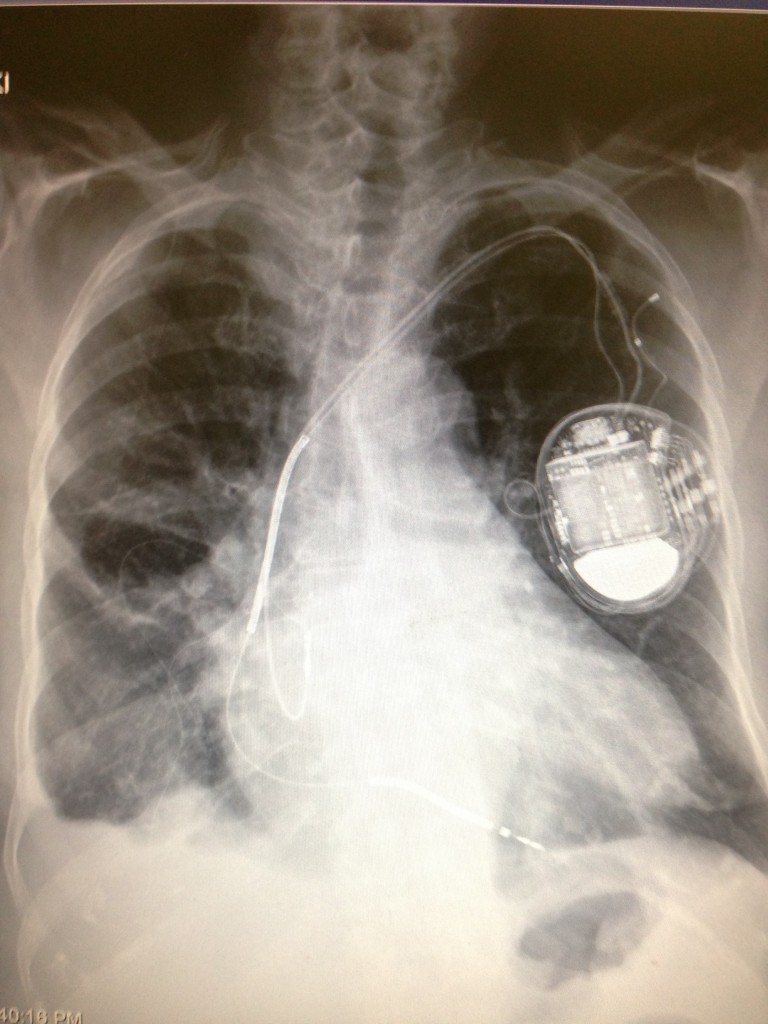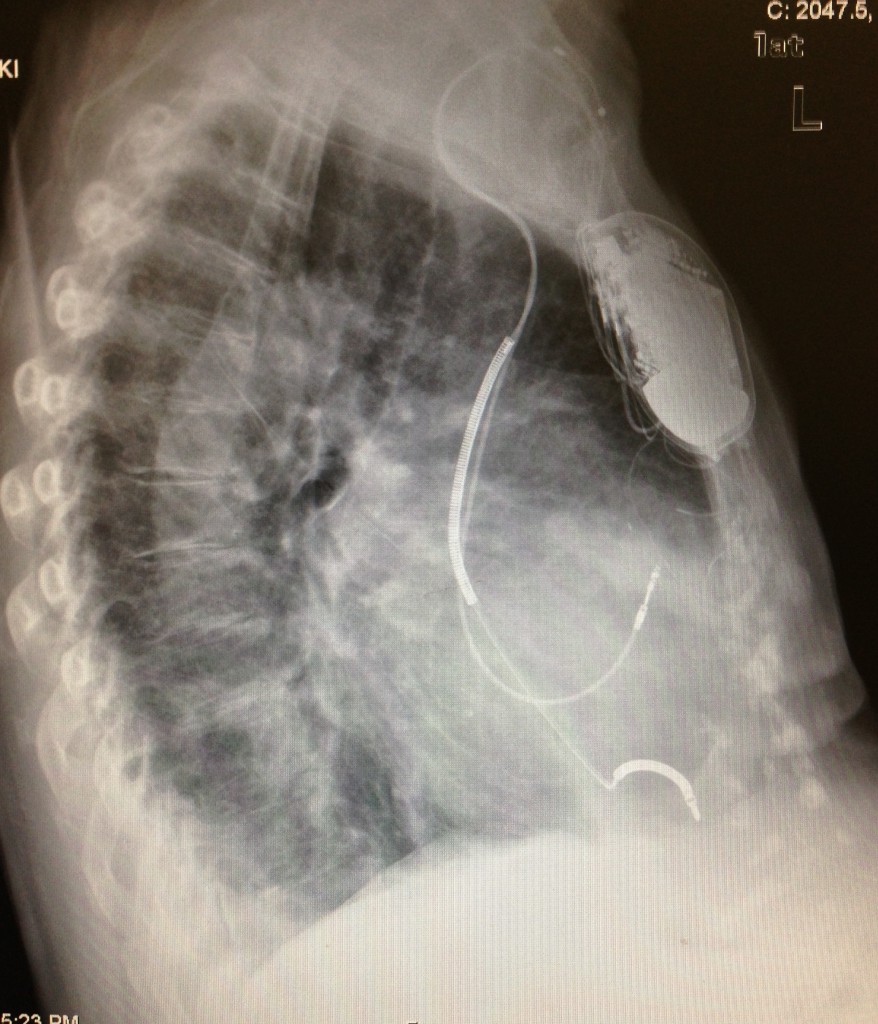So for this post… we’re going to combine some EKG action with some good ole’ CXR reading… Since we’re not just doing Rhythm Nation or X-ray Vision… we’re going to call it Rhythm Vision!
Here’s the case:
Your patient is little old granny, an 85 year old woman with a history of CHF who normally goes to another institution for her care. She has a cardiologist there… but when you ask why she didn’t go to see her own doctor she says “I don’t like my cardiologist anymore, she keeps giving me the same meds over and over”. Her chief complaint is SOB and she states that she has been having progressive worsening of her shortness of breath and dyspnea on exertion. She also says her legs have been swelling up. She has no fever, chills, cough, chest pain, nausea, vomiting. She had no recent travel. She has never had a DVT. She says she’s taking all her meds, which include a water pill and the typical CHF meds (ASA, statin, B-blocker, ACE). She’s not on digoxin. Her exam reveals JVD, bibasilar rales and 2+ pitting edema to the knee. There is no calf asymmetry. You do a basic set of labs including cardiac markers and a BNP. The troponin is negative and the BNP is 900. Labs are otherwise unremarkable. You get the following EKG and CXR (click for larger versions)!
Please interpret the EKG and CXR and post your interpretations as well as your top diagnosis. Bonus points for including the correct next step in management. Feel free to discuss your DDx but credit will only be given for your top diagnosis.
nchristopher
Latest posts by nchristopher (see all)
- What’s wrong with this picture? – Answer - September 11, 2013
- What’s wrong with this picture? - August 21, 2013
- EKG Case 8 – Answer - July 16, 2013
- EKG Case 8 – All that wheezes - June 19, 2013
- EKG Case 7 Answer - June 19, 2013




This case is interesting Neil and this old lady’s ekg and chest x-rays are harbingers of badness. This is the first time I’ve participated in this and my EKG and CXR reading skills are still in development but here I go:
EKG Analysis
Rate – Less than 50 Rhythm – NSR Axis Left PR Intervals – Don’t seem to be lengthening however QRS and P waves aren’t marching together. QRS complexes are tight however there is a RBBB block morphology in V1 – V2. Poor R-wave progression. ST segment – normal. T-wave inversions in AVL and V2. Flattening in the lateral leads.
Final Analysis: Sinus brady with RBBB morphology and left anterior fasicular block and likely third degree block
CXR – Good penetration. Tracheal deviation to the right. No fractures. Hazy cardiac borders. Increased pulmonary vascularity. Costophrenic angle on the left blunted. Loss of retrocardiac space likely effusion. Pulmonary congestion. Given two wire with larger coil on one, likely 2 chamber AICD rather than pacemaker but can’t remember off the top of my head how to distinguish the two. She might have bilaterally pneuomos..I see an abrupt stop in pulmonary vasculature b/l.
Top Diagnoses
Pulmonary HTN
Acute decompensated CHF
APE
Infection (pneumonia).
PE
Malignancy (effusion)
Next Steps:
What were her vitals?
Likely CT Chest to differentiate and better characterize pulmonary congestion. BIPAP to relieve SOB. Either Lasix or Enalprilat to relieve congestion. Empiric abx.
Okey dokey..this was hard but I tried. It’s late now…that’s all I got.
costophrenic angle actually blunted on the right..my bad!
First reply! Congrats! I did forget the vitals at triage: BP 139/82 HR 55 RR 18 T98.4 Sat 99%.
Remember to choose one diagnosis… this is not real life… you can’t admit the patient and let medicine figure it out =P
ok, my answer is a little out there.
basically agree w/ the EKG interp above. RBB + LAD (therefore LAFB). no Ps, so not third degree heart block.
but then the question is.. why is this lady’s biventricular AICD not firing with her clearly symptomatic bradycardia?
so, to the CXR. first off, it’s rotated (her left shoulder towards us). the r. atrial & r ventricular lead are in proper placement. The LV coronary sinus lead however (seen free-floating above the AICD), however is not in place. fluid in the lungs B/L. I would call this acute decompensated CHF secondary to hardware malfunction. i would treat the CHF (bipap, enalapril) and consult EP to interrogate/replace the device. admit to medicine, since HD stable.
Let’s talk ekg
Regularly irregular (bigeminy), rate is actually 60 (for irregular rhythmns, count total number of qrs on rhythm strip divided by time – in this case 10 beats/50boxes).
On an odd note the second beat in the bigeminy is not as regular as I would like. Perhaps it isn’t exactly our typical bigeminy.
I think I see 2 p waves.
There is definitely RBBB with LAFB. Likely tri-fasicular block.
But the pt has an AICD. So none of this matters. Should the AICD even be firing?
The slowest gap I see is 10s on this ekg. Let’s say it’s set to keep the rate >50, then it would not stimulate the ventricle to fire.
AICD’s can also place the atria. In this case, I don’t think it is appropriately firing in the atria because there are only 2 p waves.
Without the atria kicking blood into the ventricles, the pt will have increased cardiac work to maintain output. This extra work should lead to worsening chf.
CXR: I don’t even think I need to look. Guessing atrial part of AICD is misplaced along with typical chf stuff (enlarged heard/pulmonary effusions).
Actually looking at it, cardiomegaly/pulm eff AND random wire coming off the atrial lead and coiling around nothing.
So WendyRollerBlades is right. CHF from AICD lead misplacement. I guess I took this long to point out that you can maybe see that on the ekg alone.
Pt needs revision of AICD and basic CHF tx.
ECG shows an irregular rate, although I think I see P waves so I would dissagree with 3rd degree heart block. I agree with grock that the irregularity of the rythym is likely bigeminy given the regularity of the irregular beats. However an atrial origin such as sick sinus might account for the variation as well. As noted by others, RBBB and LAFB are present. This is trifasciular block as well as CHF is likely the reason this pt was given an ICD Biventricular device.
Moving to CXR – Agree with above, rotated, well penetrated film with pulmonary vascular congestion and right pleural effusion, and fluid noted on fissure on lateral XR. Following the various leads, the right atrial lead appears to be intact without fracture or disruption of the line and it appears to be situated appropriately in the right atrium. Similary the right ventricular lead is OK. As Wendyrollerblades saw, there is a wire extending superiorily from the AICD that ends abrubply, meanwhile there is a free wire seen floating from in the right thoracic fields. The wire that is supposed to go along the lateral wall of the left ventrical is fractured and displaced.
I found this cool website (http://radiographics.rsna.org/content/31/6/1669.figures-only) with pictures of lots of devices and various associated pathologies. I think ours is SUPPOSED to look like figures 12a and 12b.
Management: Pt will need a new lead placed along the left ventricular wall and potentially a new device altogether. I would hold B-Blockers and consult cardiology for evaluation for a percutaneous approach, although I suspect that this pt may need a cardiothoracic surgeon to retreieve the displaced wire and install a new device.
Good job all. Great case, Neil.
Couldn’t resist. Got up early for no reason….Atrial fibrillation with slow ventricular response….probably what led to PM placement in the first place. But as Grock suggested, this shit don’t matter… I’m going to shut up now and let others have a shot at the rest of it.
Thanks to Dr Neil for the case. The Hx, Phys and given workup are a slam dunk CHF exacerbation. Now we have to figure out why.
I agree with Drs Grock and Zeccola. This feels regularly irregular in a bigeminy pattern. Acknowledging that RR intervals in these couplet-y beats are not identical, so is this irregularly irregular? I’m not sure….
So is this slow sinus brady? Slow a fib? an escape rhythm? an AV blockage? Bigeminy?
Let’s start by hunting for p waves. The right-sided precordial leads are your go-to spots for “sinus” p waves. V1, V2 live over the right atrium and may show bigger amplitude p waves than other spots.. In this EKG, I think they’re there. Subtle, but there. In v1, v2. There’s two distinct and similar p-wave lookers preceding the first of the couplet beats by ~200 msec. They are again seen in lead 2, albeit much more insignificantly. Are they real? Are they artifactual hiccups? We’ll never know for sure. But by comparing them across beats, we see that they are there, the morphology is the same and that the PR intervals remain constant, and we see no non-conducted p waves. This is crucial. The conserved PR intervals and lack of dropped beats make types 2 and 3 AV blocks unlikely.
The second of the couplet beats seems to come early in the cycle for a bradycardic rhythm, making an ectopic atrial or junctional focus more likely. The RR intervals between these beats are changing, and there are varying morphologies preceding these second beats. I’m going out on a limb here and saying that this is sinus brady with frequent premature atrial and junctional complexes. Moreover; we have RBBB, LAFB and long 1st PR intervals, making this trifascicular block. I think this is the likely reason for for the dual chamber pacemaker.
The CXR shows a combination AICD and bi-V pacer. The overall rate is ~ 60 beats/sec, but during these pauses the rate drops below 50 beats/sec. We’d expect to see a pacemaker mediated beat in the mix and we don’t. It needs to be investigated….
Pearls for me: Know your radiography of cardiac devices. For a regularly irregular rhythm, think AV blocks and ectopic foci.